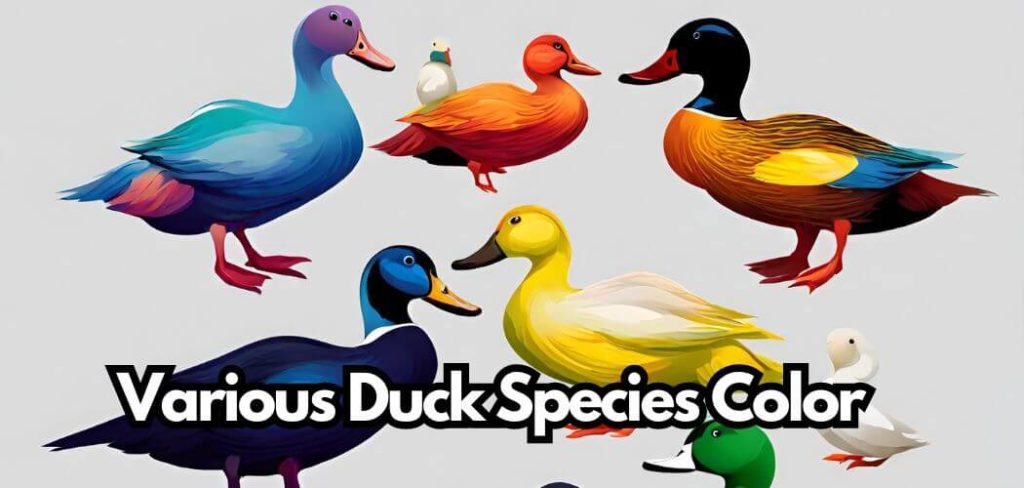Have you ever wondered if ducks can change color? While it may seem like a strange question, it’s a valid one.
After all, many animals can change their appearance to blend in with their surroundings or attract a mate. So, do ducks have this ability as well?

Do ducks change color?
The short answer is yes, ducks can change color, but it’s not as drastic as you might think.
Unlike chameleons, which can change their skin color to match their environment, ducks have limited control over their coloration.
Depending on the lighting conditions, their feathers may appear brighter or duller, and some species may undergo a partial molt that changes their appearance slightly.
It’s important to note that not all ducks molt at the same time or in the same way. Some species, such as the mallard duck, molt once a year, while others, like the eider duck, molt twice a year.
Additionally, male ducks may go through a process called “eclipse plumage,” where their colorful breeding feathers are replaced with duller ones for a brief period.
Overall, while ducks do change their feathers during molting, their color will eventually return to its original vibrancy in the end.
The different stages at which ducks change color:
Ducks are known for their beautiful and vibrant colors, but have you ever wondered when and how they change color?
Here are the different stages at which ducks change color:
Juvenile Stage:
When ducks hatch, they have soft, downy feathers that are usually a shade of yellow or brown. As they grow, their feathers start to molt and change color.
During the juvenile stage, ducks undergo their first molt, and their feathers start to develop their characteristic colors.
Eclipse Stage:
After the juvenile stage, ducks enter the eclipse stage, which occurs during the summer months.
During this time, ducks molt their colorful feathers and grow new ones that are a drabber shade of brown or grey.
This helps them blend in with their surroundings and avoid predators.
Breeding Stage:
During the breeding season, male ducks develop their bright and colorful breeding plumage to attract females.
This plumage is typically more vibrant than their non-breeding plumage and is used to display dominance and attract mates.
Non-breeding Stage:
After the breeding season, male ducks molt their bright breeding plumage and grow new feathers that are similar to their eclipse plumage.
This non-breeding plumage is used for camouflage and protection during the winter months.
Ducks change color at various stages of their life cycle, and each stage serves a different purpose.
Understanding these stages can help you appreciate the beauty and complexity of these amazing birds.
Do colors differ between duck species?
Ducks come in a wide range of colors, from the bright green of the mallard to the iridescent purple of the wood duck.
But do colors differ between duck species? The answer is yes!
Each duck species has its own unique coloration, which is often used to help distinguish it from other species.
For example, the male mallard has a bright green head, while the female has a brownish-orange head.
The wood duck, on the other hand, has a striking combination of iridescent purple, green, and blue on its head and back.
In addition to differences between species, there can also be variation within a species. For example, male mallards in different regions may have slightly different shades of green on their heads.
This variation can be influenced by factors such as diet and genetics.
It’s also worth noting that duck coloration can change throughout the year. Male ducks often have more vibrant colors during the breeding season, as they use their colorful plumage to attract mates.
Outside of the breeding season, their colors may be more muted.
What other parts of the ducks change colors as they grow?
Apart from the feathers, ducks also change the color of their bills, legs, and eyes as they grow.
The bill color of a duckling is usually yellow or brown, but it changes to orange, black, or green as the duck matures.
For instance, the bill of a Mallard duckling is yellow, but it turns green when it reaches adulthood.
Similarly, the legs of ducklings are usually yellow or brown, but they turn orange or reddish-brown as the duck grows.
The eyes of ducklings are usually dark, but they become lighter as they mature. It’s important to note that the color changes in ducks vary depending on the species.
For example, the bill of a Muscovy duck changes from pink to red, while the legs of a Pekin duck change from yellow to orange.
The color changes in duck species are fascinating and they add to the beauty of these birds.
Colors of different popular duck species:
Ducks are known for their beautiful and vibrant colors, which vary depending on the species.
Here are some of the most common colors of different species of ducks:
Mallard ducks:
The male mallard duck has a bright green head, yellow bill, grey body, and black rear end.
The female mallard duck, on the other hand, has a brownish-orange bill, a mottled brown body, and a blue patch on the wing.
Wood ducks:
The male wood duck has a colorful plumage with a green and purple head, white stripes on the face, red eyes, and a distinctive white patch on the neck.
The female wood duck, on the other hand, has a greyish-brown head and a mottled brown body.
Teal ducks:
The male teal duck has a greenish-blue head, a white crescent on the face, and a brownish body.
The female teal duck is brownish with a darker speckled pattern.
Pintail ducks:
The male pintail duck has a long, slender neck, a white breast, and a brownish body. The female pintail duck is mottled brown with a darker head and a white stripe on the neck.
Goldeneye ducks:
Both male and female goldeneye ducks have black and white plumage, with the male having a distinctive greenish-black head.
Duck’s beautiful colors are an important part of their mating rituals and social hierarchy.
Whether you are a birdwatcher or just enjoy observing nature, ducks are a fascinating and colorful species to watch.
Do duck eggs change color:
Duck eggs are known for their unique coloration and appearance. They can range from light blue to green, white, or even brown. But do these colors change over time?
The answer is no, duck eggs do not change color once they are laid. The color of the eggshell is determined by the breed of the duck and is genetically determined.
However, the color of the eggshell can vary slightly depending on the diet of the duck. For example, ducks that are fed a diet high in corn may produce eggs with a slightly more yellowish hue.
It is important to note that the color of the eggshell does not affect the nutritional value or taste of the egg. Whether the shell is blue or brown, the inside of the egg remains the same.
In summary, while the color of duck eggs may vary depending on the breed and diet of the duck, they do not change color once they are laid.
Factors that can influence color change in ducks:
A duck’s colors can vary greatly depending on various factors. Here are some of the factors that can influence the color of a duck:
Variations in the season:
The color of a duck’s feathers can change depending on the season. During the breeding season, male ducks often develop brighter and more colorful plumage to attract females.
This is known as breeding plumage. In contrast, during the non-breeding season, ducks may have duller and less vibrant colors to blend in with their surroundings to help them avoid predators.
Changes due to aging:
As ducks age, their feathers may change color. Young ducks may have different colors than adult ducks, and some species may undergo a complete change in color as they mature.
For example, male mallard ducks have a distinctive green head, but this coloration does not develop until they are around one year old.
Environmental factors:
Environmental factors such as diet, sunlight exposure, and water quality can also affect the color of a duck’s feathers.
For example, a diet rich in carotenoids can enhance the coloration of a duck’s feathers. Sunlight exposure can also affect feather color, as UV radiation can cause feathers to fade or change color.
Additionally, exposure to pollutants or chemicals in the water can lead to changes in feather color.
Final thought:
While ducks do not change color drastically, they do undergo different color changes during their lifetime.
Juvenile ducks have different plumage than adult ducks, and male ducks often have brighter and more vibrant colors than females.
However in general amongst various duck species, they offer a wide range of color and pattern variations that make them a joy to observe and appreciate in the wild and our environment.
